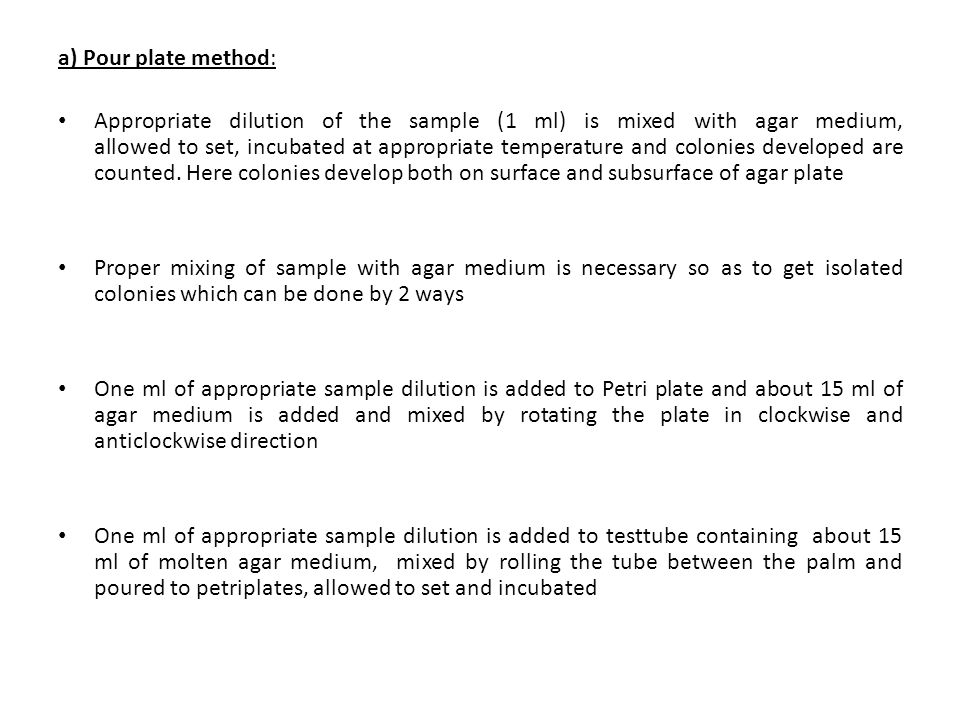What Are Some Advantages And Disadvantages Of The Serial Dilution Agar Plate Te

Abstract An important task of the clinical microbiology laboratory is the performance of antimicrobial susceptibility testing of significant bacterial isolates. The goals of testing are to detect possible drug resistance in common pathogens and to assure susceptibility to drugs of choice for particular infections. The most widely used testing methods include broth microdilution or rapid automated instrument methods that use commercially marketed materials and devices. Manual methods that provide flexibility and possible cost savings include the disk diffusion and gradient diffusion methods.
Each method has strengths and weaknesses, including organisms that may be accurately tested by the method. Some methods provide quantitative results (eg, minimum inhibitory concentration), and all provide qualitative assessments using the categories susceptible, intermediate, or resistant. In general, current testing methods provide accurate detection of common antimicrobial resistance mechanisms. However, newer or emerging mechanisms of resistance require constant vigilance regarding the ability of each test method to accurately detect resistance. Emergence of Antimicrobial Resistance and the Rationale for Performing Susceptibility Testing The performance of antimicrobial susceptibility testing by the clinical microbiology laboratory is important to confirm susceptibility to chosen empirical antimicrobial agents, or to detect resistance in individual bacterial isolates.
Empirical therapy continues to be effective for some bacterial pathogens because resistance mechanisms have not been observed e.g., continued penicillin susceptibility of Streptococcus pyogenes. Susceptibility testing of individual isolates is important with species that may possess acquired resistance mechanisms (eg, members of the Enterobacteriaceae, Pseudomonas species, Staphylococcus species, Enterococcus species, and Streptococcus pneumoniae ). Overview of Commonly Used Susceptibility Testing Methods Broth dilution tests. One of the earliest antimicrobial susceptibility testing methods was the macrobroth or tube-dilution method []. This procedure involved preparing two-fold dilutions of antibiotics (eg, 1, 2, 4, 8, and 16 µg/mL) in a liquid growth medium dispensed in test tubes [, ]. The antibiotic-containing tubes were inoculated with a standardized bacterial suspension of 1–5×10 5CFU/mL.
We can now recieve email flawlessly. Banana Accounting 6.0.8 + Crack Keygen/Serial Date added: Jan 2018 ScreenShot Copy Download Link(paste this to your browser) Review this Software Name * Email * Website Comment You may use these HTML tags and attributes: • ODOWNLOADX News • June 18 We have fixed our email. Hope you guys liked it. Email us at contact@odownloadx.com • Jan 28 OdownloadX changed it's design and layout. Banana accounting crack software.
Jan 13, 2018 - Tell us some more • Upload in Progress • Upload failed. The serial dilution agar plate procedure only accounts for living viable cells while.
Following overnight incubation at 35°C, the tubes were examined for visible bacterial growth as evidenced by turbidity. The lowest concentration of antibiotic that prevented growth represented the minimal inhibitory concentration (MIC). The precision of this method was considered to be plus or minus 1 two-fold concentration, due in large part to the practice of manually preparing serial dilutions of the antibiotics []. The advantage of this technique was the generation of a quantitative result (ie, the MIC).
The principal disadvantages of the macrodilution method were the tedious, manual task of preparing the antibiotic solutions for each test, the possibility of errors in preparation of the antibiotic solutions, and the relatively large amount of reagents and space required for each test. The miniaturization and mechanization of the test by use of small, disposable, plastic “microdilution” trays () has made broth dilution testing practical and popular. Standard trays contain 96 wells, each containing a volume of 0.1 mL that allows approximately 12 antibiotics to be tested in a range of 8 two-fold dilutions in a single tray [, ]. Microdilution panels are typically prepared using dispensing instruments that aliquot precise volumes of preweighed and diluted antibiotics in broth into the individual wells of trays from large volume vessels.